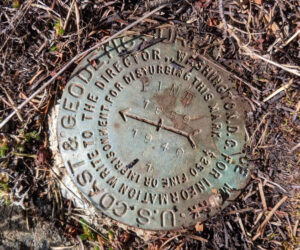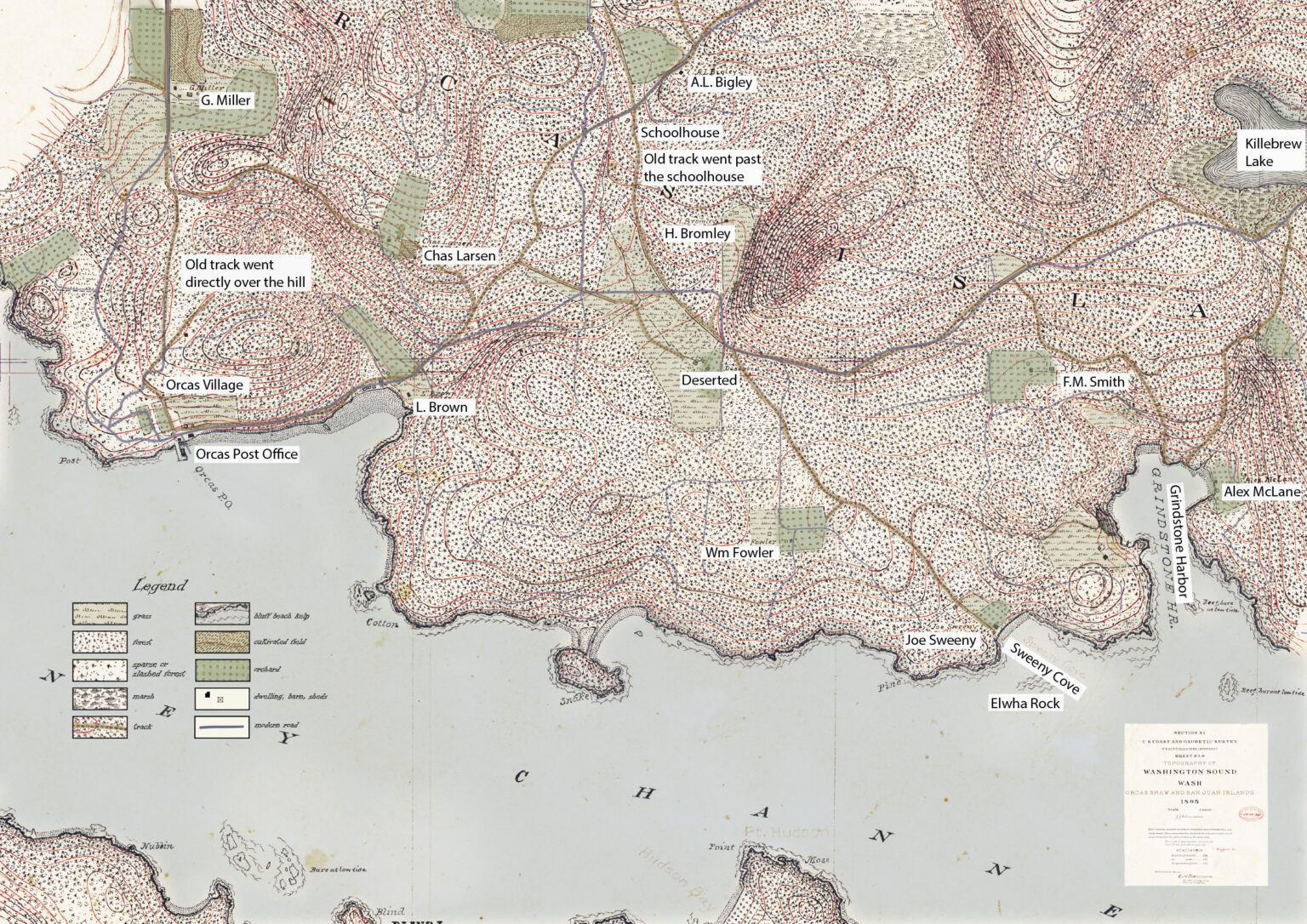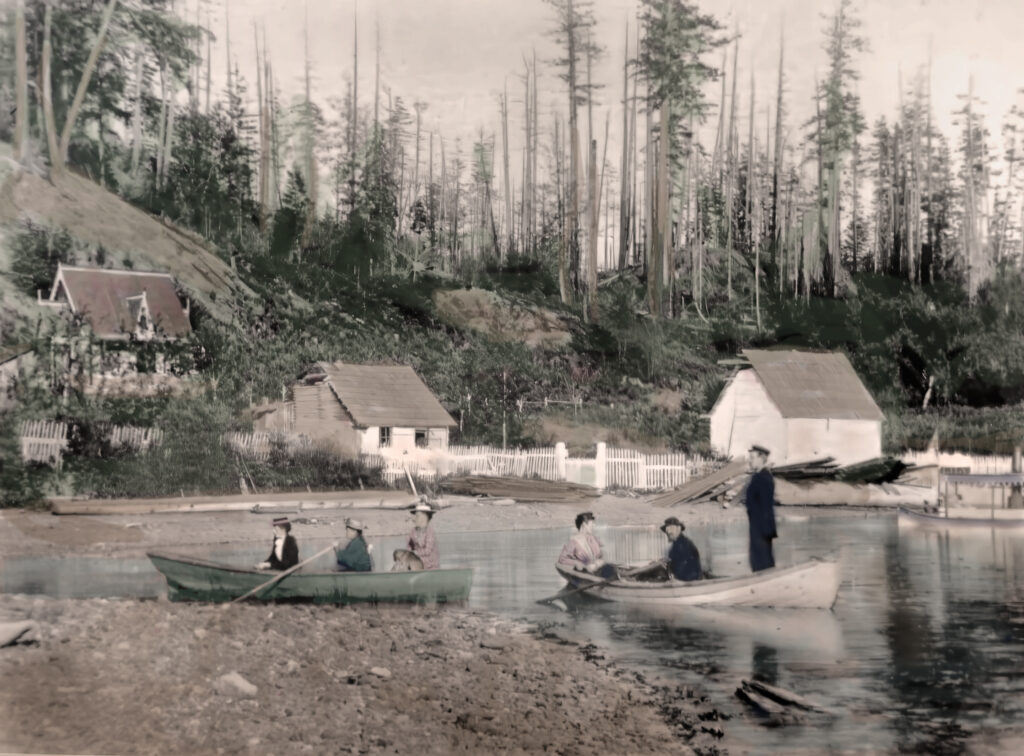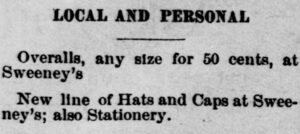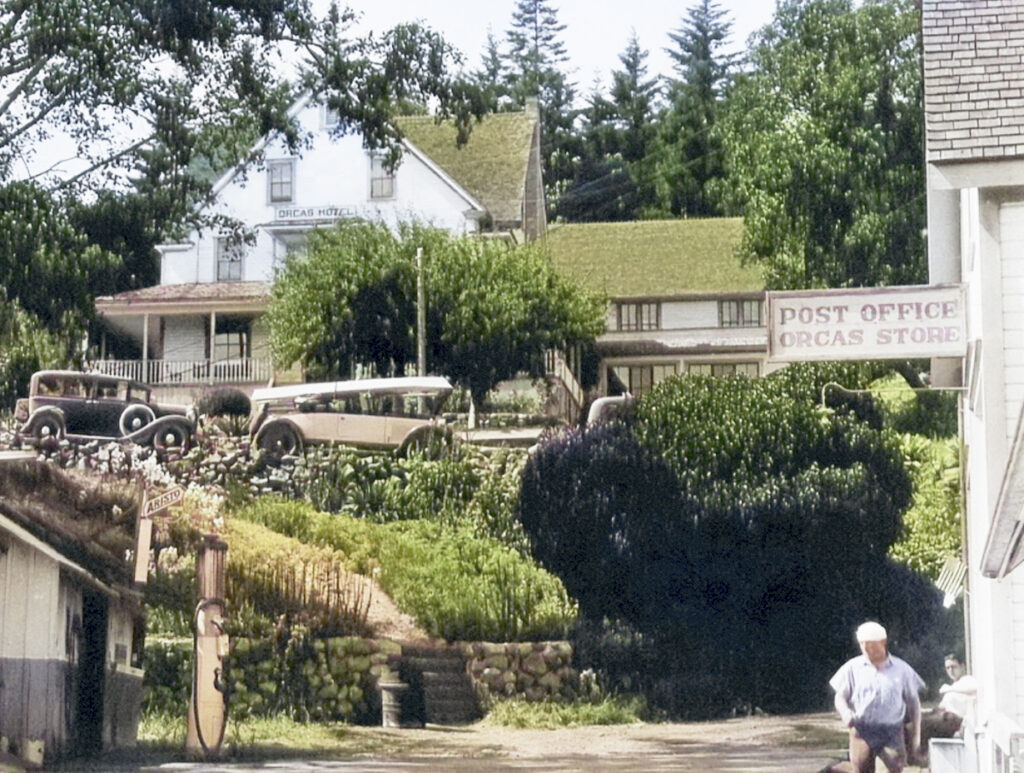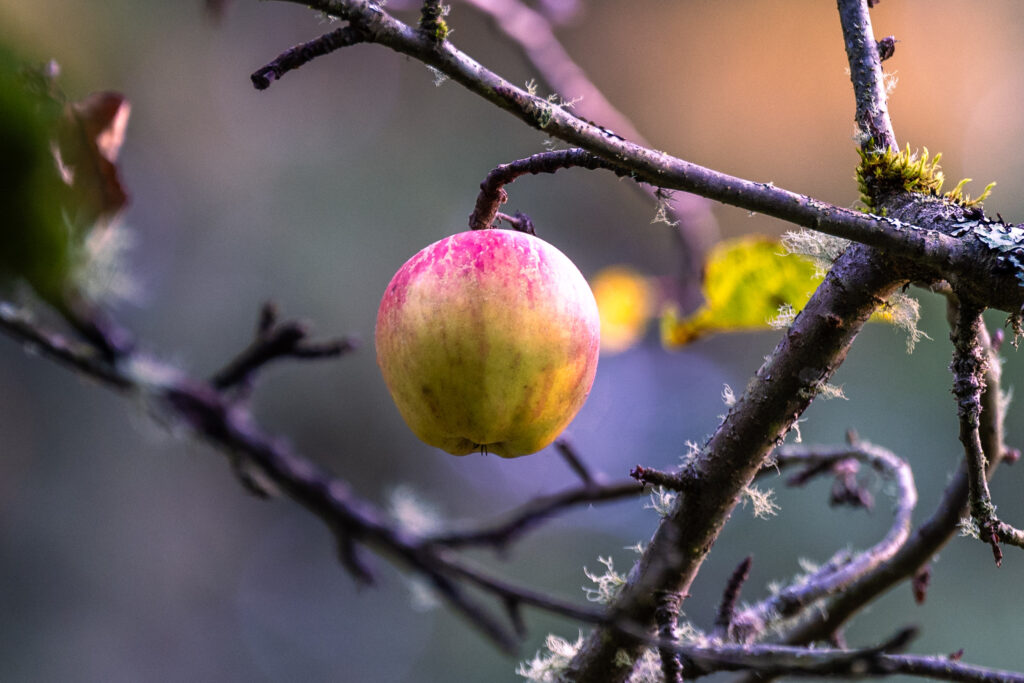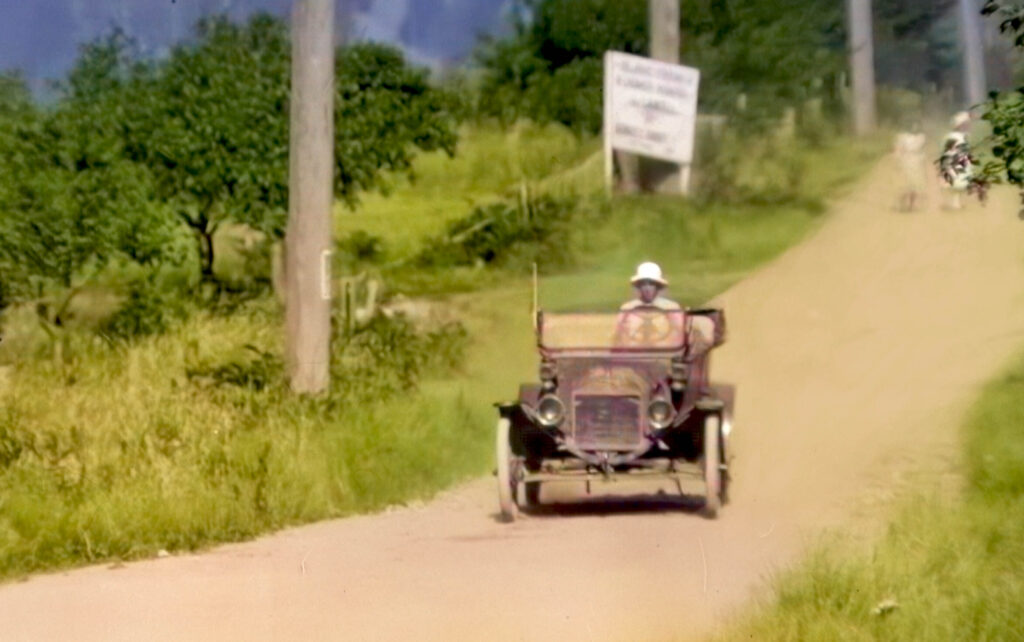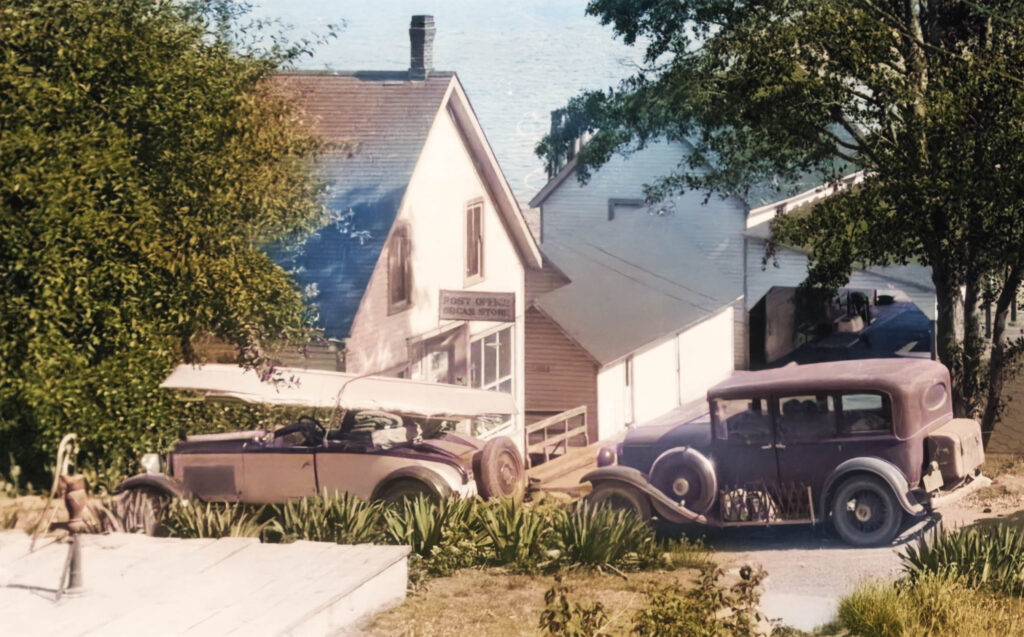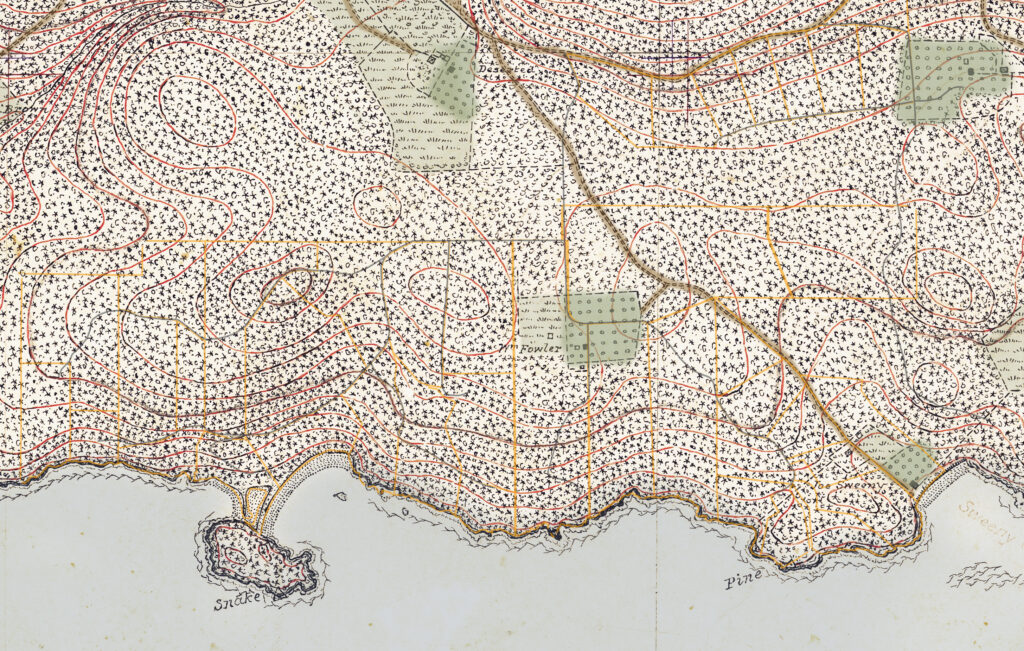Harney View Early History
Introduction
Our small community is located on Old Farm Road between what is now Orcas Landing and Grindstone Harbor. The history of Orcas Island has been covered by many, but they head straight from the landing to the bright lights of East Sound or the dizzying heights of Mount Constitution with hardly a glance at our little backwater. We aim to correct this gross injustice with a small piece of history from our quiet community.
Early History
For most of its early history the population on Orcas Island consisted of a few, small Indian villages and a handful of early European settlers. There were no roads and the coastal communities visited each other by boat or trail, as they had from time immemorial. The infamous Pig War and the American Civil War passed by with hardly a ripple in the lives of the few hardy folks who called it home. After the dispute over British claims to the San Juan Islands was resolved in 1872 American settlers arrived in earnest and things started to change.
Geodetic Survey Marker PINE 1889. The marker is located close to the beach in the Tawanda common area
Click on the map to see more details. For the best experience, expand it to full screen. Note the marker “PINE” is located on the map below the label “Joe Sweeny”
United States Coast and Geodedic Survey, 1897/1898 maps. The Originals are housed at the National Archives and Records Administration Cartographic Division in College Park, Maryland. More information about these maps can also be found at the WSU Libraries Digital Collections. The maps shown here are 400 dpi color scans created in 2025 from the originals. The originals are black ink drawings, with red contour lines. Additional colors were added for clarity on the web display. Gray lines indicate current roads based on San Juan County Polaris Property Search. Overlays of maps created over 130 years apart are not exact and for illustration purposes only.
The First Store
The first store on Orcas was opened in 1868 by Paul Kinsley Hubbs Jr. at, what is now, Grindstone Harbor.
Hubbs was looking for a place to live away from the increasingly crowded San Juan Island. He was appointed there as Inspector of Customs on April 29, 1857, after two of his predecessors quit in fear of their lives. Previously he was a Scout in the U.S. army and described by contemporaries as small, wiry and feisty, so he was the man for the job. Apart from having to hide from Indians who attacked his cabin and almost starting a war between America and England, he seemed to do quite well.
After the political upheaval calmed down on San Juan Island and more settlers arrived he sold his farm on Cattle Point. He shipped his possessions over to a small cove on Orcas Island and settled down. The serenity he was seeking did not last long. He had the only grindstone on the island and islanders came from all over and paid to use it, which gave him the idea to open a small store. Ironically for a former tax inspector, he was charged in 1874 with illegally selling tobacco without paying a special tax. After several years of running the store, he closed it down and moved to British Columbia where he spent most of his time trading with the Indians.
He ultimately moved back to San Juan Island, where he died on 18 February 1910 at age 77. The Grindstone Harbor name remains for the cove where this remarkable man had his store.
The photo, above, from a 1910 newspaper obituary for Paul K. Hubbs, Jr.
This is the only known picture of him.
The Second Store
Joseph Sweeney, a jolly, round-faced Irishman, opened a store in Sweeney Cove after Hubbs left. The location is west of Grindstone Harbor on what is now private property. Sweeney Cove appears on an early map, but it was also called Sweeney’s Beach by locals.
The store did moderately well and after several years Joseph handed it over to his younger brother Stephen. Joe then moved to Friday Harbor to open Sweeney’s Mercantile on the corner of Spring and Second Street.
Notice in San Juan Islander 1898. Overalls for 50 cents sounds like a good deal. Local men on road crews in the 1890s, earned 25 cents per hour.
The First Post Office
The first post office on Orcas Island was established in 1873 when the Sweeney obtained a license to open a post office “at a site about two miles east of the present Orcas village on the south shore of the island”. This corresponds to Sweeney’s store.
In 1885 Stephen traded the store, and presumably the post office, to Mr. Edwards in exchange for a trading schooner. The new owner sold the business, quite quickly, to William E. Sutherland, who relocated the store and the post office to the dock he built at Orcas Village. He went on to build Orcas Hotel to serve the passengers who waited for the ferry.
Orchards
The number of orchards on the 1889 map is striking. The fruit industry peaked in 1909 with 76,731 apple trees on the island, not counting pear, plum, and other fruit trees. Business was good: most of the apple trees were cider apples and the average American drank three times as much alcohol as today–a staggering 7 gallons of pure alcohol per capita per year. The passage of the 18th Amendment, prohibition, in 1919 upset the apple cart. Just 16 years later almost 60% of the apple trees were gone. Due to the cost of labor, transport, and rapacious middlemen the industry never recovered.
The middle part of Old Farm Road cuts through an orchard that was planted in the 1800s on Wm Fowler’s land. On the part that is now the Carrasco’s property there are Baldwin, Rhode Island Greening, and Yellow Bellflower apple trees as well as some pear trees remaining from the original orchard.
The apple trees are mainly Baldwins, a variety that originated as a seedling in Wilmington Massachusetts around 1740. They were popular with growers on Orcas because they ship well and are good for eating and making cider. There are also a few Rhode Island Greening, cooking-apple trees. Both the Baldwins and the Rhode Island Greening trees are triploids and produce little or no pollen, so they are usually planted with varieties, such as Yellow Bellflower to provide the important pollen. So far 100 heritage and seedling apple trees on Orcas have been genetically fingerprinted by Dr. Cameron Peace’s lab at WSU. Contact myfruittree.org if you want your trees genotyped.
Roads and Cars
The booming fruit industry also resulted in a dramatic improvement of roads on the island. The 1889 survey maps capture a unique moment in road development, just before the first automobile arrived on Orcas in 1914.
The road from Orcas Landing to East Sound went past the back of the Hotel and straight over the hill to Warm Valley. This proved too much for the first flivvers, as Ford Model Ts were called at the time, and the road was re-laid around the side of the hill, to where is today. Robert Moran personally paid for paving the road from the ferry landing all the way to Eastsound.
The road from the Ferry Landing to Grindstone Road, used to run up and around the Schoolhouse, then down to Killebrew Lake Road. This section of the road was later straightened, and even occasionally oiled up to La Porte Road, to keep the dust down. After La Porte Road, you had better hold your breath until you reach the shade at Grindstone Road.
Harry Sutherland driving the first automobile on Orcas, July 1914. Harry was just 19 years old, so it was probably his father, George’s car. – Orcas History Museum (colorized)
Cars waiting to board the ferry. Orcas Landing from Orcas Hotel, circa 1927-1932. Note the water pump in the bottom left. – Orcas History Museum (colorized)

Expanded section of 1889 topographic map showing overlay of contemporary Harney View HOA
Click on the map to see more details. For the best experience, expand it to full screen in your viewer.
Overlays of maps created over 130 years apart are not exact and for illustration purposes only.
Sources
Follow links in text
Pig War Islands by David Richardson Publisher: Orcas Publishing Co. (January 1, 1971)
A Bit Off Center by Margaret Philbrick Publisher: Paper Jam Pub (January 1, 2000)
In Her Own Footsteps: Flora Ross and Her Struggle for Identity and Independence in the Colonial West by D.J. Richardson Butterwort Books (September 15, 2020)
Orcas Island (WA) (Images of America) by Orcas Island Historical Society and Museum Publisher: Arcadia Publishing (May 15, 2006)
The San Juan islander (Friday Harbor, Wash.)
HistoryLink.org Essay 10240 By Phil Carter

